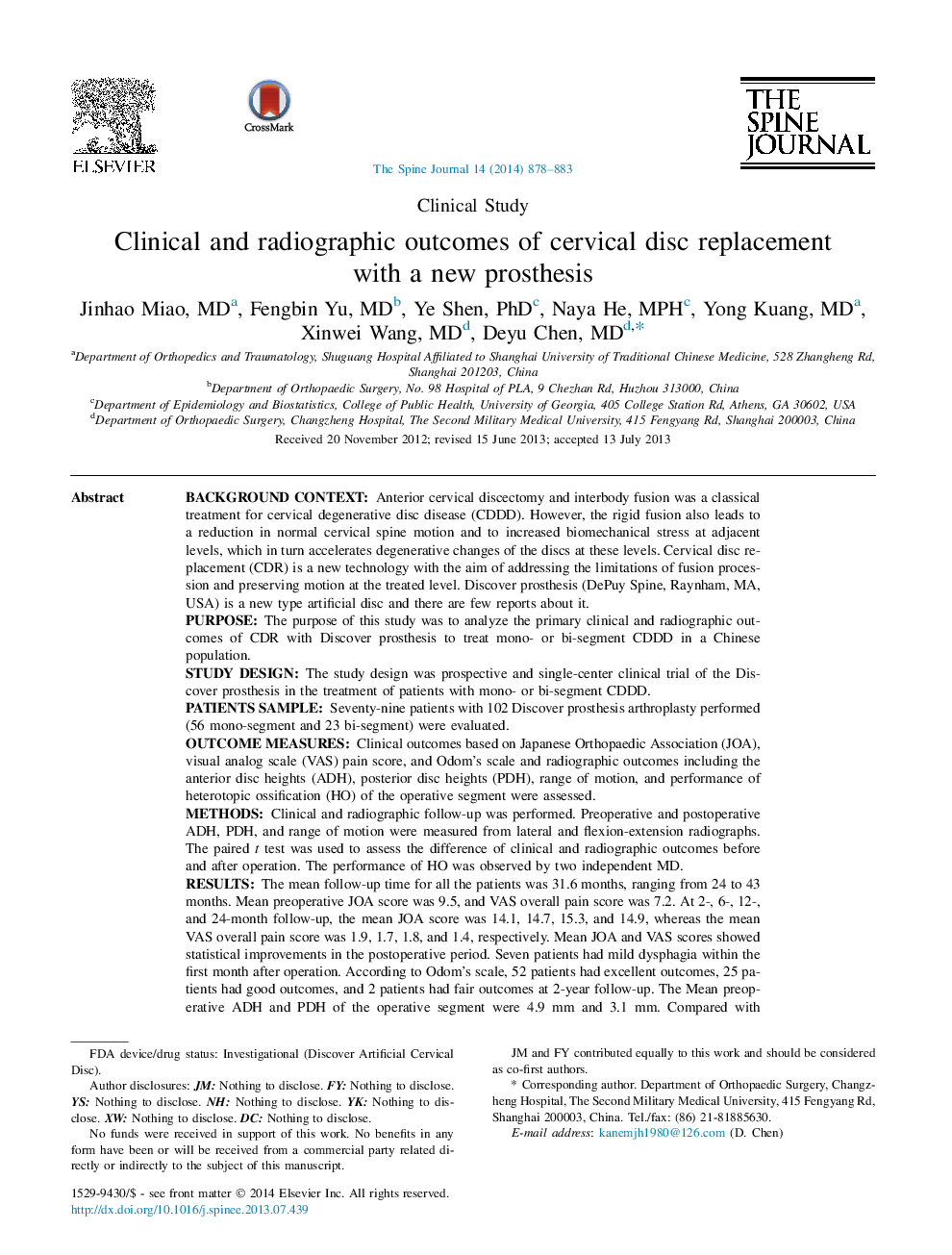| کد مقاله | کد نشریه | سال انتشار | مقاله انگلیسی | نسخه تمام متن |
|---|---|---|---|---|
| 4097761 | 1268598 | 2014 | 6 صفحه PDF | دانلود رایگان |
Background contextAnterior cervical discectomy and interbody fusion was a classical treatment for cervical degenerative disc disease (CDDD). However, the rigid fusion also leads to a reduction in normal cervical spine motion and to increased biomechanical stress at adjacent levels, which in turn accelerates degenerative changes of the discs at these levels. Cervical disc replacement (CDR) is a new technology with the aim of addressing the limitations of fusion procession and preserving motion at the treated level. Discover prosthesis (DePuy Spine, Raynham, MA, USA) is a new type artificial disc and there are few reports about it.PurposeThe purpose of this study was to analyze the primary clinical and radiographic outcomes of CDR with Discover prosthesis to treat mono- or bi-segment CDDD in a Chinese population.Study designThe study design was prospective and single-center clinical trial of the Discover prosthesis in the treatment of patients with mono- or bi-segment CDDD.Patients sampleSeventy-nine patients with 102 Discover prosthesis arthroplasty performed (56 mono-segment and 23 bi-segment) were evaluated.Outcome measuresClinical outcomes based on Japanese Orthopaedic Association (JOA), visual analog scale (VAS) pain score, and Odom's scale and radiographic outcomes including the anterior disc heights (ADH), posterior disc heights (PDH), range of motion, and performance of heterotopic ossification (HO) of the operative segment were assessed.MethodsClinical and radiographic follow-up was performed. Preoperative and postoperative ADH, PDH, and range of motion were measured from lateral and flexion-extension radiographs. The paired t test was used to assess the difference of clinical and radiographic outcomes before and after operation. The performance of HO was observed by two independent MD.ResultsThe mean follow-up time for all the patients was 31.6 months, ranging from 24 to 43 months. Mean preoperative JOA score was 9.5, and VAS overall pain score was 7.2. At 2-, 6-, 12-, and 24-month follow-up, the mean JOA score was 14.1, 14.7, 15.3, and 14.9, whereas the mean VAS overall pain score was 1.9, 1.7, 1.8, and 1.4, respectively. Mean JOA and VAS scores showed statistical improvements in the postoperative period. Seven patients had mild dysphagia within the first month after operation. According to Odom's scale, 52 patients had excellent outcomes, 25 patients had good outcomes, and 2 patients had fair outcomes at 2-year follow-up. The Mean preoperative ADH and PDH of the operative segment were 4.9 mm and 3.1 mm. Compared with preoperative, there were significantly increased and maintenance well at 2- (7.5 mm, 5.1 mm), 6- (7.5 mm, 5.0 mm), 12- (7.4 mm, 4.9 mm) and 24-month (7.2 mm, 5.0 mm) follow-up. Range of motion of the operative segment in the postoperative follow-up was slightly increased than the preoperative follow-up but not statistically significant. Heterotopic ossification was presented in six replaced levels at 1-year follow-up including 4 Grade I and 2 Grade II and 18 replaced levels at the follow-up more than 2 years including 8 grade I and 10 grade II. No prosthesis subsidence or excursion was identified.ConclusionsThe use of Discover prostheses in our study resulted in satisfactory clinical and radiographic outcomes. The prostheses can restore and maintain interbody height, while preserve the motion of the treated segment. Although the results of this study demonstrate initial safety and effectiveness in a Chinese population, we need further studies to know more about the impact of CDR with Discover prosthesis, especially on HO and adjacent segment degeneration.
Journal: The Spine Journal - Volume 14, Issue 6, 1 June 2014, Pages 878–883
